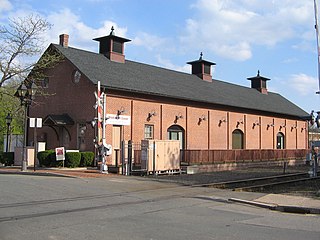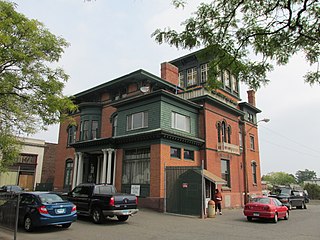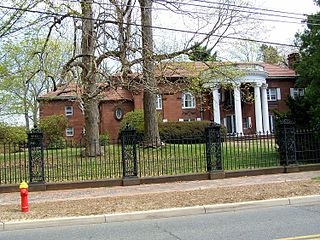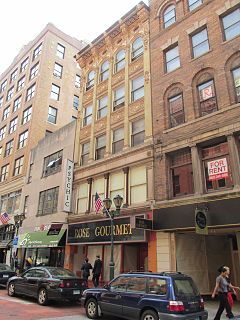
The Aldrich Public Library is the public library serving the city of Barre, Vermont. It is located at 6 Washington Street in the city center, in an architecturally distinguished Classical Revival building constructed in 1907-08 with funds bequested by Leonard Frost Aldrich, a local businessman, and was substantially enlarged in 2000. The building was listed on the National Register of Historic Places in 2016.

The Charles H. Norton House, also known as Sharpenhoe, is a historic house at 132 Redstone Hill in Plainville, Connecticut. Built in 1922, this brick Georgian Revival house was the home of inventor and machinist Charles Hotchkiss Norton (1851–1942), a Plainville native, from 1922 until his death. The house was designated a National Historic Landmark in 1976 for its association with Norton, who designed heavy-duty precision grinding machines important for development of the automobile industry.

The Phoenix Mutual Life Insurance Building, locally called the "Boat Building", is a notable Modernist office building located on Constitution Plaza in Hartford, Connecticut. Designed by Max Abramovitz and completed in 1963, it is listed on the National Register of Historic Places and is the world's first two-sided building. It is home to The Phoenix Companies.

The Hartford & New Haven Railroad Freight Depot is a historic building at 40 Mechanic Street in downtown Windsor, Connecticut, across the street from the equally historic Hartford & New Haven Railroad Depot. Built about 1870, it is a well-preserved example of a Gothic Revival freight depot. It was listed on the National Register of Historic Places in 1988. It is now the home of the Windsor Arts Center, a non-profit place that exhibits the work of visual and performing artists.

Taunton Public Library is the public library of Taunton, Massachusetts. It is located at 12 Pleasant Street, in an architecturally distinguished Beaux Arts building built in 1903 with funding support from Andrew Carnegie, to which a modern addition was made in 1979. The building is listed on the National Register of Historic Places as a particularly fine local example of Beaux Arts architecture.

The Moses Brace–Uriah Cadwell House is a historic house at 11 Flagg Road in West Hartford, Connecticut. Built in 1766, it is one of West Hartford's few surviving 18th-century buildings. It was listed on the National Register of Historic Places in 1986.

The First Church of Christ and the Ancient Burying Ground is a historic church and cemetery at 60 Gold Street in Hartford, Connecticut. It is the oldest church congregation in Hartford, founded in 1636 by Thomas Hooker. The present building, the congregation's fourth, was built in 1807, and was listed on the National Register of Historic Places in 1972. The adjacent cemetery, formally set apart in 1640, was the city's sole cemetery until 1803.

The High Street Historic District of Hartford, Connecticut is a 1.1-acre (0.45 ha) historic district that includes three buildings typifying the architectural styles of the late 19th and early 20th centuries in the city. It was listed on the National Register of Historic Places in 1998. The buildings are located at 402-418 Asylum Street, 28 High Street, and 175-189 Allyn Street, and includes the Batterson Block and Judd and Root Building, each individually listed for their architecture.

The John Wells Jr. House is a historic house at 505 Mountain Road in West Hartford, Connecticut. Built about 1766, it is one of the town's few surviving 18th-century buildings, and a good example of Georgian residential architecture. The house was listed on the National Register of Historic Places on September 10, 1986.

The Simsbury Bank and Trust Company Building, also known as the former Town Hall Building, is a historic commercial and civic building at 760 Hopmeadow Street in Simsbury, Connecticut. Built in 1917, it is a prominent local example of Colonial Revival architecture with Beaux Arts features. It originally housed the town's first bank, and was its town hall between 1969 and 1984. The building was listed on the National Register of Historic Places in 1986.

The Porteous, Mitchell and Braun Company Building, also known as the Miller Building, is an historic building at 522-28 Congress Street in downtown Portland, Maine. Built in 1904 and enlarged in 1911, it housed Portland's largest department store for many years, and is a fine example Renaissance Revival architecture. It was listed on the National Register of Historic Places in 1996. It now houses the primary campus facilities of the Maine College of Art.

The Hartford Municipal Building, also known as Hartford City Hall, is a historic Beaux-Arts structure located at 550 Main Street in Hartford, Connecticut. Completed in 1915, it is a prominent local example of Beaux-Arts architecture, and is the third building to serve as city hall. It was added to the National Register of Historic Places in 1981.

49-51 Spring Street in Hartford, Connecticut is a significant local example of Richardsonian Romanesque residential architecture. It was built about 1890 for the locally prominent Allyn family; its architect is unknown. It was listed on the National Register of Historic Places in 1983.

The Lucius Barbour House is a historic house at 130 Washington Street in Hartford, Connecticut. Built in 1865, it is a high-quality local example of Italianate architecture executed in brick. It is also noted for its interior, which is a well-preserved later Victorian remodeling of the original. The house was listed on the National Register of Historic Places in 1979.

Beleden House is a historic house at 50 Bellevue Avenue in Bristol, Connecticut. Built in 1908-10, it is a prominent and rare example of a high-quality residence in the Beaux Arts style. It was listed on the National Register of Historic Places in 1982.

The City Hall-Monument District encompasses the city hall complex and central municipal park of New Britain, Connecticut. A prominent part of the city's downtown business district, the city hall is an architecturally distinguished former hotel, while the park includes a substantial Beaux Arts Civil War memorial. The district was listed on the National Register of Historic Places in 1973.

The Day-Taylor House is a historic house at 81 Wethersfield Avenue in Hartford, Connecticut. Built in 1857, it is one of state's best examples of Italianate villa architecture executed in brick. It was listed on the National Register of Historic Places in 1975. It presently houses offices.

The Dillon Building is a historic commercial building located at 69-71 Pratt Street in Downtown Hartford, Connecticut. Built in 1899, it is a good local example of Beaux Arts architecture, and its construction exemplified the transition of Pratt Street from a residential to commercial area. The building was listed on the National Register of Historic Places on February 11, 1982.

The Townsend G. Treadway House is a historic house at 100 Oakland Street in Bristol, Connecticut. Built in 1915, it is one of the city's largest and finest examples of Colonial Revival architecture, designed by a major New York architectural firm. It was listed on the National Register of Historic Places in 1991.

The Webster Memorial Building is a historic house at 36 Trumbull Street in downtown Hartford, Connecticut. Built in 1870 and extensively restyled in 1924, it is a rare example of Georgian Revival architecture in the downtown area, noted for its historical association with the Family Services Society, a prominent local charity. The building, now in other commercial use, was listed on the National Register of Historic Places in 1982.


























